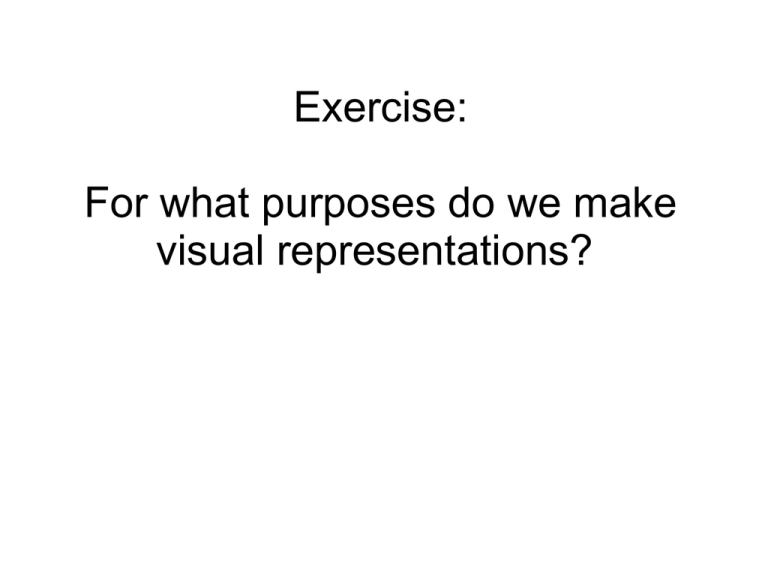Exercise: For what purposes do we make visual representations?
advertisement

Exercise: For what purposes do we make visual representations? Visualisation is as old as humanity Paleolithic cave paintings, Lascaux, France, ca. 30000 years ago. Image from http://www.culture.gouv.fr/cult ure/arcnat/lascaux/en/ These are visual representations of objects that are remembered or imagined – products of abstract visualisation. Paleolithic figurine, “Venus of Willendorf,” ca. 25000 years old. Image from Wikipedia Human seeing is built of multiple components Detection: Contrast: Light vs. dark Gradients, shading Motion, direction Relative distance & size Patterns, orientation Edges - parallax, stereopsis Color discrimination Object discernment and Object recognition, visual computation Human seeing is built of multiple components: detection, contrast, object discernment Human seeing is built of multiple components: object discernment A classic illustration of object-background discrimination Spring peeper (frog), Pseudacris crucifer Image from http://www.uri.edu/cels/nrs/paton/photo_sppe.htm Exercise: What is an image? Most imaging depends on manipulating and detecting electromagnetic radiation E-M radiation is is usually treated as propagating waves. Wavelength is inversely proportional to frequency: λ = c/ν Energy is directly proportional to frequency: and inversely proportional to wavelength: E = hν E = hc/λ Refraction changes the direction of propagation at an interface Light waves travel more slowly in media such as glass or water Image from http://www.williamson-labs.com/optical-body.htm This website has some nice introductory optics material. Index of refraction is a measure of resistance to light propagation Refractive index = speed of light in vacuum / speed of light in material Snell's law: Index of refraction depends on wavelength, and is different for different materials Wavelength dependence of refractive index for some glasses. This function is also known as a dispersion curve. visible Focus is a composite effect of refraction (or of reflection) http://www.williamson-labs.com from Hecht and Zajac, Optics The focusing effect of a lens can reconstruct wavefronts from an object. This is known as image formation. 1/f = 1/so + 1/si (the Gaussian Lens equation) An image can also be formed by removing all the unfocused rays. This is the principle of a pinhole camera. This CCD pinhole camera is only $65 at spygadgets.com Undesigned lenses can form images Flower in the background imaged through hanging dew drops From http://www.flickr.com/groups/macroviewers/discuss/72157594313729574/ Thus imperfect eyes can be useful. Parabolic surfaces are used to focus radiofrequency signals and sunlight. Your home satellite dish has the shape of a part of a paraboloid. A radio telescope works the same way, but with a larger dish. satellite communication: satellite dish antenna." Online Art. Encyclopædia Britannica Online. <http://www.britannica.com/eb/art-67385>. A cylindrical paraboloid reflector makes an effective solar heat collector. The center pipe usually has water or another fluid pumped through it. Each point on a parabola will reflect normallyincident light to the parabola's focus point. normal (=90°) incidence axis The surface formed by rotating a parabola about its axis is a paraboloid. A parabolic refracting surface (e.g. a glass lens) will also focus parallel rays to a point. A discontinuous array of reflectors can approximate a larger parabolic dish The Solar One solar power station Barstow, California, 1993 PIX Number 00036 Sandia National Laboratories National Renewable Energy Laboratory U.S. Department of Energy copyright, U.S. Department of Energy The Solar One mirror array as seen on Google Earth. Likewise, a discontinuous array of refracting surfaces can approximate a lens A Fresnel lens (right) has most of the refracting surface of a solid spherical lens (left). A Fresnel lens can give the same focusing power with much less glass, so it can be much thinner and lighter.




